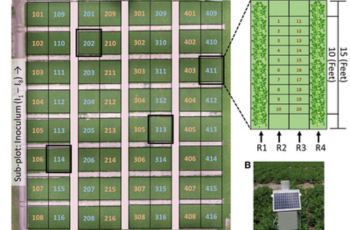Abstract
Peanuts grown in tropical, subtropical, and temperate regions are susceptible to stem rot, which is a soilborne disease caused by Athelia rolfsii. Due to the lack of reliable environmental-based scheduling recommendations, stem rot control relies heavily on fungicides that are applied at predetermined intervals. We conducted inoculated field experiments for six site-years in North Florida to examine the relationship between germination of A. rolfsii sclerotia: the inoculum, stem rot symptom development in the peanut crop, and environmental factors such as soil temperature (ST), soil moisture, relative humidity (RH), precipitation, evapotranspiration, and solar radiation. Window-pane analysis with hourly and daily environmental data for 5- to 28-day periods before each disease assessment were evaluated to select model predictors using correlation analysis, regularized regression, and exhaustive feature selection. Our results indicated that within-canopy ST (at 0.05 m belowground) and RH (at 0.15 m aboveground) were the most important environmental variables that influenced the progress of mycelial activity in susceptible peanut crops. Decision tree analysis resulted in an easy-to-interpret one-variable model (adjusted R2 = 0.51, Akaike information criterion [AIC] = 324, root average square error [RASE] = 14.21) or two-variable model (adjusted R2 = 0.61, AIC = 306, RASE = 10.95) that provided an action threshold for various disease scenarios based on number of hours of canopy RH above 90% and ST between 25 and 35°C in a 14-day window. Coupling an existing preseason risk index for stem rot, such as Peanut Rx, with the environmentally based predictors identified in this study would be a logical next step to optimize stem rot management.
https://apsjournals.apsnet.org/doi/10.1094/PHYTO-05-23-0164-R



